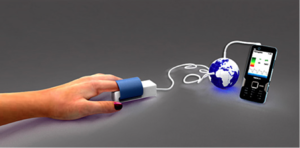
Problem being addressed[edit | edit source]
Women during childbearing years are particularly susceptible to anemia. There are an estimated 100,000 maternal and 600,000 newborn deaths a year due to the blood disorder, with millions more affected. Thus far, it has been difficult to influentially screen for anemia in developing countries because it requires individual testing, a process that is time consuming and unrealistic in low-resource facilities.
Detailed description of the solution[edit | edit source]
The Hemoglobe is an inexpensive phone attachment that transforms rural health workers' phones into non-invasive and prick-free hemoglobinometers. They automatically relay hemoglobin results to a central server in order to map out anemia prevalence and where help is needed most, geographically. This allows for community-based screening and anemia awareness in areas with high prevalence.
Designed by[edit | edit source]
- Designed by: Johns Hopkins University Center for Bioengineering Innovation and Design
- Manufacturer location: Baltimore, Maryland USA
When and where it was tested/implemented[edit | edit source]
2011-2012, Kenya
Funding Source[edit | edit source]
Johns Hopkins University, Finalist in Saving Lives at Birth Competition
References[edit | edit source]
Other internally generated reports[edit | edit source]
Johns Hopkins University. (July 24 2012). Undergraduates' Cellphone Screening Device for Anemia Wins $250,000 Prize. Retrieved November 13 2013 from here.
Externally generated reports[edit | edit source]
Saving Lives at Birth. (August 6 2012). HemoGlobe: Revitalizing Maternal Anemia Prevention and Treatment Globally. Retrieved November 13 2013 from here.